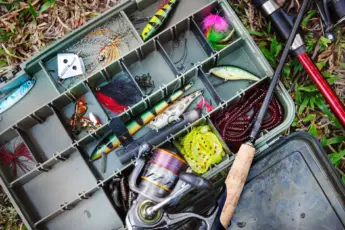One of the most challenging tides to fish is the king tide. The king tides are extra high tides that occur most often during full moon phases. Without question, the water level rises to above-average heights, which means the water is flowing rapidly. I have seen tides on the full moon peak two feet above a standard high tide. Not only does the current move swiftly as tides change, but what is often visible at high tide becomes submerged beneath the surface. Here is what you need to know about the challenges of fishing king tides in coastal waters.
Drifting Baits Is Nearly Impossible
Without question, the water flows much faster during a full moon tide. Unfortunately, this negatively impacts anglers.
I have fished these tides on numerous occasions and always catch fewer fish. One of the primary reasons this is the case is because of the drift rate of the bait.
Most often, I fish a popping cork with a live shrimp on the hook beneath. The float moves at a significantly swifter pace compared to a standard tide. Unfortunately, the fish have little chance to pounce on the bait as it passes by structures, including docks, oyster beds, and marsh grass.
Comparatively, the same applies to dropping a weight and hook to the bottom. Before you know it, the hook, weight, and bait have been pulled by the current well out of the strike zone.
The Fish Move Into The Marsh Grass
During the full moon tide, coastal flood advisories are issued along the coast due to the extra high water.
The high water levels allow fish to explore and feed in locations deeper into the marsh grass. These areas are nutrient-rich because they flush out food, creating a feasting haven for redfish, sea trout, flounder, and more.
Unfortunately, the backwaters are challenging to reach by boat unless, of course, you’re using a skiff with a poleing platform.
If you are going to fish the super high tide, I would suggest waiting until the water vacates the deep marsh. Unquestionably, the fish will be forced to venture out and back to the areas where they are most often located.
The Water Clarity Is Significantly Reduced
There is a direct correlation between strong currents and reduced water clarity. When the water flows rapidly, it is more prone to stirring up the seafloor below and turning it into a coffee brown color.
No doubt about it: it is more challenging to catch fish when the water becomes more stirred up than usual.
First, the fish must rely on scent solely when casting with live bait because the clouded water prevents them from being seen.
Secondly, artificial baits must be put on the fish’s nose also because of reduced visibility. If a fish can’t see the artificial bait being worked through the water, they won’t chase it down from a distance.
Combining Wind And King Tides Makes Waves
The combination of navigating through a strong tide combined with a moderate to stiff wind presents challenges.
One of the primary ways that waves are formed is when the wind direction is opposite of the direction of the current.
The movement of wind opposite the current stacks waves that are steep and unpleasant. Undoubtedly, you will become wet from seaspray when the two patterns are present simultaneously.
Additionally, you can expect to be bounced around as you cast your line. Ensure that your friends or family know they are more prone to falling down.
I recently fished a king tide that was combined with a strong, strong current. The odds were stacked up against us to catch fish, but we managed to put a couple in the boat. However, we found trouble remaining balanced when casting. Additionally, we became soaked when moving from spot to spot and back to the dock.
It is imperative to check the wind forecast before deciding to head out fishing on a full moon tide. You’re likely better off waiting for a better weather day.
Avoid Fishing King Tide
Look, if you decide to fish king tide, understand that the odds are stacked up against you before you even head to the marina or boat ramp. I believe the best bet is to wait for another day when the tides return back to normal. If you do decide to head, use caution. The boat is more challenging to maneuver, and swift currents present a risk if someone goes overboard. Remain patient while casting and capitalize on every strike.







